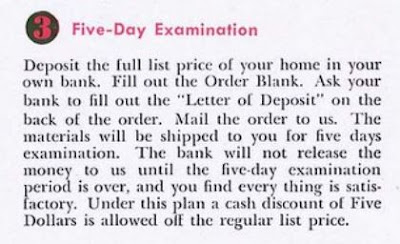Call me a cynic, but I often wonder why kit houses were not stolen. When a customer dropped a bunch of building materials on their lot, it would have been easy pickings for anyone criminal-minded.
And then I recently uncovered a story about a stolen kit house that made national news in 1937.
 |
| Headline from October 1937. |
Let's set the stage for this nefarious plot.
One of the national kit house companies was the Lewis Manufacturing Company of Bay City, Michigan. In 1937, Lewis Manufacturing was selling houses in the Chicago area.
Lewis Manufacturing offered a "five-day examination" payment plan which meant they would send the customer a house with no money down. The customer would deposit the full amount for the house at their local bank. The bank would send a letter to Lewis Manufacturing stating that they were holding the money. After the customer received the building materials, the bank would release the money to Lewis Manufacturing.
 |
| Description of the payment plan from the Lewis Manufacturing homes catalog. |
%20-%20Copy.jpg) |
| Tauber (left) and Heersema. Photo from the Chicago Tribune. |
On September 11, the building materials arrived by train in Chicago, and two men claimed the order and loaded it onto three trucks.
Needless to say, Lewis Manufacturing never received the $763. A representative from the company tried to track down Midwest Service Company, but found the company was no longer at the Dearborn Street address. After further investigation, officials from Lewis Manufacturing learned that the office space had been rented to a Michael Tauber and that Tauber had also purchased a supply of business stationery.
Police obtained a warrant that charged conspiracy to defraud, and Tauber immediately confessed to taking the lumber. He told prosecutors that he and Heersema rented the trucks and took the lumber to Tauber's house. Tauber then used the materials to build a two-car garage on his property and a new porch.
.jpg) |
"Harseema [sic] and I worked the scheme out together," Tauber said to a reporter from the International News Service. "It looked good but I guess there must have been a weak spot somewhere, huh?"
This story went viral and was in newspapers nationwide. Editors had fun with the headlines.
State authorities turned over the case to federal prosecutors. Tauber and Heersema were charged with using the mails to defraud.



%20-%20Copy.jpg)





4 comments:
Fun story! Who doesn't love a good mystery? Especially one involving a house! Glad that the culprits were caught. I can't help but wonder if Tauber's garage and porch might still exist... if so they would be fascinating anomalies in kit-house lore.
Great minds think alike! I looked for it... the house, porch, and garage are gone.
Sad. Whoever demolished the house and garage likely had no idea of the unique and quirky history which was destroyed. I will forever wonder if Tauber just tacked on the porch which was pre-cut for the Sterling or if he was more creative with the lumber he stole! If only Street View existed in 1937!
Wow, this is really interesting... I had missed that you posted this!
Post a Comment